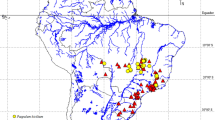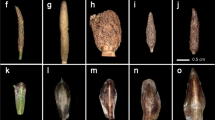Abstract
Smilax china L. is a widespread species in China with different ploidy levels. It is morphologically similar to S. davidiana, S. trinervula, and S. glauco-china. In this study, the chromosome number and the variation in allozyme patterns of eight enzyme systems with 25 alleles in 11 populations of S. china and three affinitive species were investigated. The allozyme data, together with morphological and cytological data, suggest that S. glauco-china is not closely related to the other taxa investigated. The diploid species S. davidiana and S. trinervula are involved as ancestor species and share great introgressions with S. china. In S. china, populations from Guilin and Guiyang are allotetraploid; their diploid progenitors probably are diploid populations of S. china and S. trinervula. The results suggest this species arose from multiple origins.



Similar content being viewed by others
References
Andrew JL, Richard JA (2000) Routes of origin of two recently evolved hybrid taxa: Senecio vulgaris var. hibernicus and york radiate groundsel (Asteraceae). Am J Bot 87:1159–1167
Chen XQ, Koyama T (2000) In: Wu ZY, Raven PH (eds) Flora of China, Liliaceae (in English), vol 24. Science Press, Beijing, and Missouri Botanical Garden Press, St. Louis
Crawford DJ, Orndu R (1992) Enzyme electrophoresis and evolutionary relationships among three species of Lastenia (Asteraceae: Heliantheae). Am J Bot 76:289–296
Eastwood A, Vogel JC, Gibby M, Cronk QCB (2004) Relationships and genetic diversity of endemic Elaphoglossum from St Helena. Plant Syst Evol 245:107–118
Fu CX, Hong DY (1990) A chromosome study on 7 species of Smilax L. Acta Phytotax Sin 28:211–222
Fu CX, Shen CD, Huang AJ, Hong DY (1995) Variation and evolution of the karyotype in Smilax and Heterosmilax (Smilacaceae) III: analyses of karyotypes and evolution from 12 taxa in southern China. Chathaya 7:105–124
Fu CX, Shen CD, Zhong GQ, Hong DY (1993). Variation and evolution of the karyotype on Smilax: Karyotype analysis of seven species from southern China. Chathaya 5:151–166
Gallze GP, Gottlieb LD (1982) Genetic evidence for the hybrid origin of the diploid plant Stephanomeria diegensis. Evolution 36:1158–1167
Gottlieb LD (1981) Electrophoretic evidence and plant populations. Prog Phytochem 7:1–46
Grant V (1981) Plant speciation. Columbia University Press, New York
Guldahl AS, Borgen L, Nordal I (2001) Variation in the Festuca brachyphylla (Poaceae) complex in Svalbard, elucidated by chromosome numbers and isozymes. Bot J Linn Soc 137:107–126
Hardy OJ, Loose MD, Vekemans X, Meerts P (2001) Allozyme segregation and inter-cytotype reproductive barriers in the polyploid complex Centaurea jacea. Heredity 87:136–145
Haufler CH, Windham MD, Johns RJ (1995) Reticulate evolution in the Polypodium vulgare complex. Syst Bot 20:89–109
Herrero A, Pajaron S, Prada C (2001) Isozyme variation and genetic relationships among taxa in the Asplenium obovatum group (Aspleniaceae, Pteridophyta). Am J Bot 88:2040–2050
Hörandl E, Greilhuber J (2002) Diploid and autotetraploid sexuals and their relationships to apomicts in the Ranunculus cassubicus group: insights from DNA content and isozyme variation. Plant Syst Evol 234:85–100
Hsu CC (1967) Preliminary chromosome studies on the vascular plants of Taiwan (I). Taiwania 13:117–130
Hsu CC (1971) Preliminary chromosome studies on the vascular plants of Taiwan (IV). Taiwania 16:123–136
Huang AJ, Shen CD, Fu CX (1997) The chromosome number of 13 species in Smilax L. J Wuhan Bot Res 15:279–280
Huber W, Leuchtmann A (1992) Genetic differentiation of the Erigeron species (Asteraceae) in the Alps: a case of unusual allozymic uniformity. Plant Syst Evol 183:1–19
Kephart SR (1990) Starch gel electrophoresis of plant isozymes: a comparative analysis of techniques. Am J Bot 77:693–712
Kong HH, Wang AL, Lee J, Fu CX (2007) Studies of systematic evolution and karyotypic variation in Smilax and Heterosmilax (Smilacaceae). Acta Phytotaxon Sin 45:257–273
Koyama T (1960) Materials toward a monograph of the genus Smilax. Quart J Taiwan Mus 13:1–61
Koyama T (1975) Smilacaceae. Flora of Thailand, vol 2, part 3, pp 232–234
Mahy G, Bruederle LP, Connors B, Hofwegen MV, Vorsa N (2000) Allozyme evidence for genetic autopolyploidy and high genetic diversity in tetraploid cranberry, Vaccinium oxycoccos (Ericaceae). Am J Bot 87:1882–1889
Nakajima G (1937) Cytological studies in some dioecious plants. Cytologia FJN 282–292
Oja T, Jaaska V, Vislap V (2003) Breeding system, evolution and taxonomy of Bronmus arvensis, B. japonicus and B. squarrosus (Poaceae). Plant Syst Evol 242:101–117
Qu L, Hancock JF, Whallon JH (1998) Evolution in an autopolyploid group displaying predominantly bivalent pairing at meiosis: genomic similarity of diploid Vaccinium darrowi and autotetraploid V. corymbosum (Ericaceae). Am J Bot 85:698–703
Ramsey J, Schemske DW (1998) Pathways, mechanisms, and rates of polyploid formation in flowering plants. Annu Rev Ecol Syst 29:477
Raymond O, Piola F, Sanlaville-Boisson C (2002) Inference of reticulation in outcrossing allopolyploid taxa: caveats, likelihood and perspectives. Trends Ecol Evol 17:3–6
Roose ML, Gottlieb LH (1976) Genetic consequences of polyploidy in Tragopogon. Evolution 43:586–594
Rosquist G, Prentice HC (2002) Genetic variation in Scandinavian Anthericum liliago (Anthericaceae): allopolyploidy, hybridization and immigration history. Plant Syst Evol 236:55–72
Sato D (1942) Karyotype alteration and phylogeny in Liliaceae and allied families. Jpn J Bot 12:57–132
Sharma IK, Jones DL, Forster PI (2004) Genetic differentiation and phenetic relatedness among seven species of the Macrozamia plurinervia complex (Zamiaceae). Biochem Syst Ecol 32:313–327
Soltis DE (1985) Allozyme differentiation among Heuchera americana, H. parviflora, H. pubescens and H. villosa (Saxifragaceae). Syst Bot 10:193–198
Soltis DE, Haufler CH, Darrow DC, Gastony GJ (1983) Starch gel electrophoresis of ferns: a complication of grinding buffers, gel and electrode buffers, and staining schedules. Am Fern J 73:9–27
Soltis DE, Soltis PS (1999) Polyploidy: recurrent formation and genome evolution. Trends Ecol Evol 14:348–352
Soltis PS, Soltis DE (2000) The role of genetic and genomic attributes in the success of polyploids. Proc Natl Acad Sci USA 97:7051–7057
Stebbins GL (1971) Chromosomal evolution in higher plants. Edward Arnold, London
Stebbins GL (1985) Polyploidy, hybridization and the invasion of new habitats. Ann Mo Bot Gard 72:824–832
Swofford DL, Selander RB (1981) BioSys-1: a Fortran program for the comprehensive analysis of electrophoretic data in population genetics and systematics. J Hered 72:281–283
Tyler T (2003) Allozyme variation in Carex sect. Digitatae: evidence of introgression, genetic distinctiveness and evolution of taxa. Plant Syst Evol 237:219–231
Tyler T (2004) Studies in the Melica ciliate complex: 1. Distribution of allozyme variation within and among individuals, populations and geographic regions. Plant Syst Evol 248:1–30
Tyler T (2005) Patterns of allozyme variation in Nordic pilosella. Plant systematics and evolution (published online January)
Wang FZ (1934) Note on Chinese Liliaceae. Bull Fan Mem Inst Biol 5:111–122
Wang FZ, Tang J (1978) Flora of China, vol 15. Science Press, Beijing, pp 180–246
Wang ZR (1996) Plant allozyme analysis. Science Press, Beijing (in Chinese with English notes)
Wang ZR, Wang KQ, Zhang F, Hou X (2003) A biosystematic study on Asplenium sarelii complex. Acta Bot Sin 45:1–14
Wendel JF (2000) Genome evolution in plants. Plant Mol Biol 42:225–249
Werth CR (1991) Isozyme studies on the Dryopteris “spinulosa” complex, I: the origin of the log fern Dryopteris celsa. Syst Bot 16:446–461
Acknowledgments
Special thanks are extended to Shichao Chen for his assistance with plant collecting, as well as to the National Science Foundation of China (grants 30170062) for financial support.
Author information
Authors and Affiliations
Corresponding author
Rights and permissions
About this article
Cite this article
Wang, A., Chen, Y., Chen, G. et al. Relationships and Hybridization among Smilax china and Its Affinities: Evidence from Allozyme Data. Biochem Genet 46, 281–292 (2008). https://doi.org/10.1007/s10528-008-9155-9
Received:
Accepted:
Published:
Issue Date:
DOI: https://doi.org/10.1007/s10528-008-9155-9




